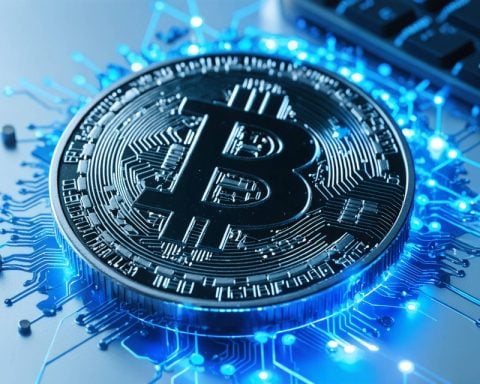- The debate between XRP and Bitcoin often centers on their supply, but Ripple’s CTO, David Schwartz, urges a broader evaluation.
- Bitcoin is frequently hailed for its scarcity due to a 21 million coin cap, earning it the title of “digital gold.”
- Schwartz criticizes the focus on supply figures, likening it to comparing distances in inches versus miles; true value lies in market capitalization, divisibility, and utility.
- Despite XRP’s larger supply and lower price, its utility and Ripple’s partnerships offer significant value.
- Investors are advised to understand both cryptocurrencies comprehensively, recognizing their distinct roles in the market.
- With potential regulatory changes and discussions of an XRP ETF, the crypto debate remains active and evolving.
In the world of cryptocurrency, where fanfare often meets fervor, the debate over XRP and Bitcoin stirs emotions like few others. Ripple’s Chief Technology Officer, David Schwartz, boldly challenges the narrative that pits these two digital titans against one another based merely on their supply.
As discussions whirl around Bitcoin’s revered scarcity and its symbolic stature as “digital gold,” Ripple enthusiasts urge for a broader lens. Bitcoin boasts a fixed 21 million cap, leading some to shout its superiority like a mantra. However, Schwartz’s insights cut through this noise, illuminating the pitfalls of narrow evaluations that cling to supply figures.
His analogy is striking: judging cryptocurrencies by their raw numbers alone is akin to measuring distances in inches versus miles. Schwartz points out that such talks miss the point where the real value lies—market capitalization, divisibility, and utility, not just shiny price tags per coin. He suggests looking beyond superficial figures and exploring the depths of economic forces shaping value.
Diving deeper, Schwartz sheds light on a common misconception: that XRP’s apparent lower price marks it as a “better buy.” This notion, however tempting, is deceptive. Despite its larger supply, XRP’s utility and potential—fueled by Ripple’s partnerships with financial giants—present a different kind of allure.
In a market landscape as dynamic as the crypto world, the lesson remains: understand fully before you invest. With regulatory winds shifting and whispers of a possible XRP ETF in the air, the conversation about these cryptocurrencies is far from over. For astute investors, the art lies in seeing beyond numbers, recognizing that both XRP and Bitcoin have distinct roles and prospects, shaped by much more than their supply or prices suggest.
XRP vs. Bitcoin: Unveiling Potential Beyond Price Tags in the Crypto Showdown
How-To Steps & Life Hacks: Understanding Cryptocurrency Value
When engaging with cryptocurrencies such as XRP and Bitcoin, understanding their value involves more than just looking at price. Here is how you can deepen your evaluation:
1. Evaluate Utility: Analyze how a cryptocurrency is used within its ecosystem. Ripple’s XRP, for example, is used in cross-border payments, which can be a value determinant beyond its price.
2. Market Capitalization: Focus on market cap instead of just price. Market capitalization offers a more comprehensive picture of a coin’s overall market value.
3. Investigate Partnerships: Consider the partnerships and real-world applications of the crypto asset. Ripple’s alliances with financial institutions can impact XRP’s potential growth.
4. Research Regulations: Stay informed about the regulatory environment as this can significantly affect the legal status and adoption of cryptocurrencies.
Real-World Use Cases
Bitcoin is widely recognized as a store of value, often compared to “digital gold.” Its decentralized nature makes it valuable for transactions that require privacy and security.
XRP, on the other hand, is a bridge currency meant to facilitate transactions between different fiat currencies on the Ripple network. It supports financial institutions in streamlining cross-border transactions, making it effective for international remittances.
Market Forecasts & Industry Trends
Both XRP and Bitcoin are positioned for growth with unique industry trends:
– Bitcoin: Institutional adoption is increasing, with large companies holding Bitcoin as a reserve asset. The Bitcoin Halving event also raises prospects of reduced supply, potentially increasing demand.
– XRP: The potential approval of an XRP Exchange-Traded Fund (ETF) could improve its market position, coupled with financial institutions increasingly using Ripple’s technology for cross-border solutions.
Reviews & Comparisons
Bitcoin Pros:
– Decentralized and secure.
– A limited supply creating scarcity.
– High liquidity and brand recognition.
Bitcoin Cons:
– High transaction fees.
– Slow transaction speeds.
XRP Pros:
– Fast transaction speeds, processing transactions in seconds.
– Low transaction costs.
– Strong network of institutional partnerships.
XRP Cons:
– Regulatory challenges impacting its adoption.
– Centralized ownership concerns with Ripple controlling a substantial portion of XRP.
Controversies & Limitations
XRP faces ongoing scrutiny from regulatory bodies such as the SEC, which has impacted its trading and perception. Centralization concerns also arise with Ripple Labs holding a large percentage of the total XRP supply, leading to debates over decentralization.
Bitcoin’s limitations include its energy consumption criticized for environmental reasons and scalability issues relating to its transaction capacity.
Features, Specs & Pricing
– Bitcoin:
– Block time: 10 minutes
– Scalability: Up to 7 transactions per second
– Price: Subject to high volatility
– XRP:
– Block time: 3-5 seconds
– Scalability: Up to 1,500 transactions per second
– Price: Lower than Bitcoin but heavily influenced by market conditions
Security & Sustainability
Bitcoin depends on its Proof of Work consensus mechanism, leading to significant energy consumption, causing sustainability concerns.
XRP’s consensus protocol is less energy-intensive, making it more sustainable compared to Bitcoin. However, the centralization debate persists as a key security concern.
Insights & Predictions
The long-term prospects for both cryptocurrencies depend significantly on how they diversify use cases and adapt to the regulatory landscape. While Bitcoin is well-placed as a store of value, XRP’s utility in financial systems offers unique advantages.
Actionable Recommendations
– Educate yourself on the nuances of each cryptocurrency’s utility and real-world applications.
– Diversify your portfolio to mitigate risks.
– Keep track of regulatory news and industry developments for informed investment decisions.
– Utilize credible crypto analysis platforms and communities to gather insights (e.g., CoinDesk, Cointelegraph).
By looking beyond superficial metrics like price, investors can make more informed decisions about where to allocate their resources in the evolving landscape of digital currency.













